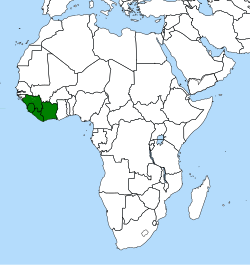Top Qs
Timeline
Chat
Perspective
Triphyophyllum
Genus of carnivorous plants From Wikipedia, the free encyclopedia
Remove ads
Triphyophyllum peltatum is a facultatively carnivorous,[2] up to 60 m tall vine[3] in the monotypic genus Triphyophyllum /ˌtrɪfioʊˈfɪləm/ in the family Dioncophyllaceae native to tropical western Africa, in Guinea, Ivory Coast, Liberia, and Sierra Leone[4] where it grows in tropical rainforest.[3]
Remove ads
Description
Summarize
Perspective



Vegetative characteristics
It is a facultatively carnivorous,[2] heterophyllous,[5] up to 60 m tall vine[3] with glabrous, terete stems.[6] It has a three-stage lifecycle, each with a different shaped leaf, as indicated by its Greek name. In the first stage, T. peltatum forms a rosette of simple lanceolate Dracaena-like leaves about 18 cm (7.1 in) in length with undulate margins. At times when there is insufficient phosphorus in the soil[7][8] it develops long, slender, glandular, circinate leaves up to 35 cm (14 in) in length and bearing two sorts of glands, and resembling those of the related Drosophyllum, which capture insects; there being one to three of these leaves in each rosette.[9] In the plant's adult liana form it has short non-carnivorous leaves bearing a pair of "grappling hooks" [10] at their tips on a long twining stem which can become 50 metres (160 ft) in length and 10 centimetres (3.9 in) thick.[11][12] T. peltatum is the largest of all confirmed carnivorous plants in the world, but its carnivorous nature did not become known until 1979, over 50 years after the plant's scientific description.[5]
Generative characteristics
The axillary,[13][14] branched,[15] cymose, few-flowered[14] or many-flowered inflorescence bears up to 80 small, ephemeral,[15] fragrant,[13] white to pink,[15] bisexual, actinomorphic, pedicellate flowers.[14] The pedicel is up to 3 cm long. The flower has 5 triangular, 2 mm long sepals, and 5 obovate, 13 mm long petals.[14] The androecium consists of 10 stamens.[14][6] The style is very short.[6] The up to 4 cm wide, 1-seeded,[14] 4–5-valved capsule fruit[6][14] bears discoid, papery,[14] flat, winged, circular, pink to red,[13] 5–8[6](–10) cm wide seeds[16][13] with an up to 5.5 cm long funiculus extending beyond the fruit.[14] Most of the seed's development occurs outside the fruit.[17] The seeds are wind-dispersed.[6][18]
Cytology
Remove ads
Taxonomy
Triphyophyllum peltatum was first described as Dioncophyllum peltatum Hutch. & Dalziel by John Hutchinson and John McEwan Dalziel in 1927.[1] It was moved to a new monotypic genus Triphyophyllum Airy Shaw as Triphyophyllum peltatum (Hutch. & Dalziel) Airy Shaw by Herbert Kenneth Airy Shaw in 1952.[4][1]
Etymology
The generic name Triphyophyllum is derived from triphyes meaning of threefold form,[19] and phyllum meaning leaf.[20] It refers to the three growth stages of the plant with three different types of leaves.[7] The specific epithet peltatum means shield-like[21] and refers to the discoid seeds,[18] which have a long stalk that extends the seed beyond the capsule fruit.[14]
Remove ads
Distribution and habitat
Triphyophyllum is found in Guinea, Ivory Coast, Liberia, and Sierra Leone,[4] where it occurs in primary[6] and old secondary dry evergreen rainforests. The habitat has a 6–7 month dry season. The acid, nutrient-poor soil is shallow.[5]
Conservation
It is a rare and endangered species.[7]
Cultivation
Triphyophylum peltatum is difficult to cultivate.[7][22] It is cultivated in several botanical gardens: Würzburg, Hannover,[23] Abidjan, Bonn, Cambridge University and Würzburg[citation needed], and is exceedingly rare in private collections.
Uses

Triphyophyllum peltatum is traditionally used in folk medicine in the treatment of elephantiasis,[14][6] and malaria.[6] It produces many pharmaceutically active secondary metabolites, some of which have been found to have strong antiplasmodial activity. Some metabolites were found to have antitumoral and anti-multiple myeloma activity.[7] The stems are used as tying material.[14]
Remove ads
References
External links
Wikiwand - on
Seamless Wikipedia browsing. On steroids.
Remove ads


